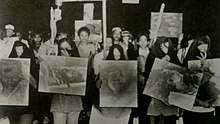Human rights abuses of the Marcos dictatorship
The ‘top two’ torturers, Col. Rolando Abadilla and Lt. Rodolfo Aguinaldo were allegedly trained by CIA operatives in the United States.
[6] Many of the ‘salvaged’ bodies dumped in public view bore intense torture marks, instilling fear about what happens to those who oppose the Marcos regime.
[42] According to the Marjanie Salic Macasalong's study The Liberation Movements in Mindanao: Root Causes and Prospects for Peace, the number of Moro victims killed by the Army, Philippine Constabulary, and the Ilaga (a notorious government-sanctioned[43] terrorist cult known for cannibalism and land grabbing that served as members of the CHDF)[35] reached as high as 10,000 lives.
Aside from human rights abuses, these units also hounded media entities,[50][51] corporate management,[52] and opposition groups[53] with threats, intimidation, and violence.
[55] The international community eventually got word of these human rights violations and applied pressure to the Marcos dictatorship to end them.
Amnesty International's first report about the Philippines in December 1975 revealed the “systematic and severe torture” handled by the Fifth Constabulary Security Unit (5CSU).
[5][7] Amnesty International found convincing evidence of widespread torture among prisoners, enabled by Marcos's suspension of the writ of habeas corpus and the absence of judicial oversight.
[6] This caused tensions between the United States and the Philippines, pressuring Marcos to admit human rights violations during his regime.
[58] But he eventually confessed at the 1977 World Peace through law Conference in Manila that “there have been, to our lasting regret, a number of violations of the rights of detainees”.
[62] On the stories of human rights abuses, Bongbong Marcos describes them as "self-serving statements by politicians, self-aggrandizement narratives, pompous declarations, and political posturing and propaganda.
